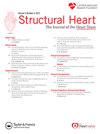经导管球囊扩张主动脉瓣置换术后小主动脉环和大主动脉环患者血流梯度模式的结果
IF 2.8
Q3 CARDIAC & CARDIOVASCULAR SYSTEMS
引用次数: 0
摘要
背景:小环空患者在经导管主动脉瓣置换术(TAVR)后血流动力学表现更差的风险。小环是否会带来更糟糕的结果尚存争议。本研究探讨了主动脉狭窄(AS)小环和大环患者经血流梯度亚组TAVR后的临床结果。方法:这是一项回顾性队列研究,纳入了2016年至2020年在克利夫兰诊所接受TAVR治疗的18岁患者。根据环的大小将患者分为小组(面积≤430 mm2)和大组(面积>;430 mm2)。排除了经食管超声心动图显示瓣膜自扩张的TAVR患者和经食管超声心动图显示瓣膜环形缩小的患者。每组又分为经典低流量低梯度AS、矛盾低流量低梯度AS、正常流量低梯度AS和高梯度AS。临床结果包括死亡率和心力衰竭再住院。结果纳入1866例患者,其中小环空709例(38%)。在4种血流梯度模式下,两组心力衰竭再住院和死亡率均无差异:经典LFLG AS患者的风险比(HR) = 0.93(95%可信区间[CI]: 0.51-1.69),矛盾LFLG AS患者的风险比(HR) = 0.95, CI(0.62-1.47),正常血流低梯度AS患者的风险比(HR) = 1.16, CI(0.49-2.74),高梯度AS患者的风险比(HR) = 0.73, CI(0.50-1.07),以大环为参考。环空较小的患者tavr后平均梯度较高,无量纲瓣膜指数较低,低减薄小叶增厚和瓣膜结构恶化的发生率较高。结论小环空和大环空的tavr患者在所有血流梯度模式下均具有相似的中期临床结果。本文章由计算机程序翻译,如有差异,请以英文原文为准。
Outcomes of Patients With a Small and Large Aortic Annulus Following Balloon-Expandable Transcatheter Aortic Valve Replacement Across Flow-Gradient Patterns
Background
Patients with small annuli are at risk for worse hemodynamic performance after transcatheter aortic valve replacement (TAVR). It is debatable whether a small annulus confers worse outcomes. This study explored the clinical outcomes following TAVR for patients with small and large annuli across flow-gradient subgroups of aortic stenosis (AS).
Methods
This is a retrospective cohort of patients >18 years who underwent TAVR at Cleveland Clinic between 2016 and 2020. Patients were classified into 2 groups according to annular size: small (area ≤430 mm2) and large (area >430 mm2). Patients undergoing TAVR with self-expanding valves and those with annular sizing using transesophageal echocardiography were excluded. Each group was subclassified into classical low-flow low-gradient (LFLG) AS, paradoxical LFLG AS, normal-flow low-gradient AS, and high-gradient AS. Clinical outcomes included mortality and heart failure rehospitalization.
Results
The study included 1866 patients, of which 709 (38%) had small annuli. There was no difference in heart failure rehospitalization and mortality between the groups in any of the 4 flow-gradient patterns: hazard ratio (HR) = 0.93 (95% confidence interval [CI]: 0.51-1.69) for patients with classical LFLG AS, HR = 0.95, CI (0.62-1.47) for patients with paradoxical LFLG AS, HR = 1.16, CI (0.49-2.74) for patients with normal-flow low-gradient AS, and HR = 0.73, CI (0.50-1.07) for patients with high-gradient AS, using large annulus as a reference. Patients with small annuli had higher mean gradients, lower dimensionless valve index, and a higher incidence of hypoattenuated leaflet thickening and structural valve deterioration post-TAVR.
Conclusions
Patients with small and large annuli have similar intermediate-term clinical outcomes post-TAVR across all flow-gradient patterns treated with balloon-expandable valve.
求助全文
通过发布文献求助,成功后即可免费获取论文全文。
去求助
来源期刊

Structural Heart
Medicine-Cardiology and Cardiovascular Medicine
CiteScore
1.60
自引率
0.00%
发文量
81
 求助内容:
求助内容: 应助结果提醒方式:
应助结果提醒方式:


